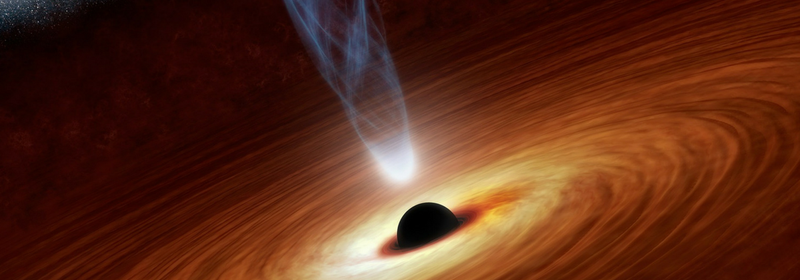
Black Holes: Waterfalls in Space
“What goes up must come down,” they say. But is this true?
Article Header
« Return to Main PageBlack Holes: Waterfalls in Space
“What goes up must come down,” they say. But is this true?
by Maxwell Lorentz
“What goes up must come down,” they say. But is this true?
Throw a ball, straight up, as hard as you can. It goes up—and then comes down. If you could throw it 1,000 miles per hour, it would go more than 6 miles high—and then come down. If you could throw it 10,000 mph, it would go twice as high as the Hubble Space Telescope—and then fall back. But if you could throw the ball 26,000 mph, it would keep going and never return—because this speed is faster than Earth’s escape velocity.[1] The Earth’s escape velocity is about 25,020 mph, and anything slower than this will return to Earth. Anything faster will not.
Objects with more mass have higher escape velocities. The Sun’s escape velocity is about 1.4 million mph, and, for the white dwarf Sirius B, it is over 15 million mph. But what if the escape velocity is higher than the speed of light? In 1783, an English pastor/scientist (named John Michell) first asked this question. In this case, he realized, even light could not escape. He called such objects dark stars. Today we call them black holes.
Now, Michell was ahead of his time, but he didn’t have all the details correct. In fact, we may not have all the details correct either—but we at least have the advantage of a better theory of gravity. Michell had to use Newton’s theory—which makes very good predictions in normal situations. But when the gravity gets extremely strong (like it does around a black hole), Newton’s theory totally breaks down, and you need Einstein’s theory of General Relativity instead.
 Einstein’s theory tells us that it is misleading to think about escape velocity and black holes—because when you throw a ball in the air, it first goes up before it starts back down. But in a black hole, light doesn’t do this. It never has a chance to go up—all it can do is go down. In fact, you can think of the space around a black hole like a river about to plunge over a waterfall. If a fish can swim faster than the current, then it can escape the falls. But if the water flows faster than the fish can swim, it can’t ever escape—in fact, it can’t make any headway at all. No matter what it does, the current will sweep it downstream.
Einstein’s theory tells us that it is misleading to think about escape velocity and black holes—because when you throw a ball in the air, it first goes up before it starts back down. But in a black hole, light doesn’t do this. It never has a chance to go up—all it can do is go down. In fact, you can think of the space around a black hole like a river about to plunge over a waterfall. If a fish can swim faster than the current, then it can escape the falls. But if the water flows faster than the fish can swim, it can’t ever escape—in fact, it can’t make any headway at all. No matter what it does, the current will sweep it downstream.
And a black hole is like a waterfall, with space itself streaming into the hole.[2] The closer you get, the faster the space flows—and at some point, the space is flowing faster than the speed of light. Now, Einstein’s theory says space can go faster than the speed of light, but no object can. So at this “point of no return,” nothing can swim against the black hole waterfall—not even light.
 This “no return” boundary is called the event horizon. Near the event horizon, gravity makes strange things happen. If you could watch through a telescope from far away, you would see things move more and more slowly the closer they were to the event horizon—indeed, from your viewpoint, time itself would slow down near the black hole (gravitational time dilation). But if you were near the black hole yourself, the time wouldn’t feel slow to you. To you, everyone else’s time would be running fast.
This “no return” boundary is called the event horizon. Near the event horizon, gravity makes strange things happen. If you could watch through a telescope from far away, you would see things move more and more slowly the closer they were to the event horizon—indeed, from your viewpoint, time itself would slow down near the black hole (gravitational time dilation). But if you were near the black hole yourself, the time wouldn’t feel slow to you. To you, everyone else’s time would be running fast.
Not that I suggest you try the experiment—the tidal forces around most black holes would shred you (and your ship) to dust before you even got close. But if, somehow, you could survive, you would notice other strange things too. If the black hole is rotating, you would find a region called the ergosphere, where the rotation drags the surrounding space so fast that nothing can stand still. And once you pass the event horizon itself, there’s a sense in which space and time switch places—you can’t stop your fall to the center any more than you can stop your progress into the future. Nothing can stop you from being crushed to a single point when you reach the singularity at the center.
 So let’s stay outside the event horizon and watch what happens to gas before it gets sucked in. As gas spirals closer and closer, it loses potential energy (because it’s falling). Friction turns this lost potential energy into heat. And when a gas gets hot enough, it glows. Around many black holes, this spiraling gas reaches a fiery several million degrees, which is hot enough to emit X-rays. We think this radiation is what powers quasars at the centers of active galaxies.
So let’s stay outside the event horizon and watch what happens to gas before it gets sucked in. As gas spirals closer and closer, it loses potential energy (because it’s falling). Friction turns this lost potential energy into heat. And when a gas gets hot enough, it glows. Around many black holes, this spiraling gas reaches a fiery several million degrees, which is hot enough to emit X-rays. We think this radiation is what powers quasars at the centers of active galaxies.
And there’s at least one other type of radiation from black holes. When you combine quantum field theory with general relativity, you find (strangely enough) that black holes actually “evaporate” by emitting something called Hawking radiation. The evaporation process is incredibly slow—most black holes would take many trillions of trillions of years to evaporate. So black holes last a long time, but not quite forever.
In future articles, we’ll look at two major types of black holes—supermassive black holes millions (or billions) of times more massive than the Sun, and stellar mass black holes up to several times the mass of the Sun.
But we’ll conclude this article with an ironic fact—gravity, which gives black holes their inexorable power, is literally the weakest force known to man. Of the four fundamental forces, gravity is by far the weakest. The other three (electromagnetism, the color force, and the weak force) are—particle for particle—billions of times stronger than gravity. But these other forces never create black holes. So how can gravity, which is so weak, become so strong? Here’s the reason: besides being a long-range force (unlike the color and weak forces), gravity (unlike electromagnetism) doesn’t have “positive” or “negative” charges that cancel out. Instead, every particle in the earth works together to pull you down, and every bit of mass in a black hole works together to warp space into an irresistible waterfall. Like the locusts in Proverbs 30:24–28, weak things working together can be very strong. And thus the weakest force in the universe—gravity—builds black holes, the most powerful objects known to man.
[1] It never actually escapes Earth’s gravity (technically Earth’s gravitational field goes on forever), but the gravity will never slow the ball down enough to make it stop.
[2] The Gullstrand-Painlevé metric gives this analogy a precise mathematical formulation. (For more information, see http://jila.colorado.edu/~ajsh/insidebh/waterfall.html.) There are other valid metrics too.









